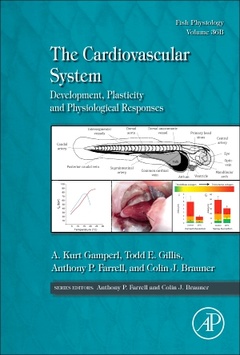The Cardiovascular System Development, Plasticity and Physiological Responses Fish Physiology Series
Coordonnateurs : Gamperl A. Kurt, Gillis Todd E., Farrell Anthony, Brauner Colin

The Cardiovascular System: Phenotypic and Physiological Responses, Volume 37, part of a two-volume set, provides comprehensive coverage of the current state of knowledge in this very active and growing field of research, also highlighting the tremendous diversity in cardiovascular morphology and function among the various fish taxa and the anatomical and physiological plasticity shown by this system when faced with various abiotic and biotic challenges. Specific chapters in this updated book include Research Technologies/Methodology for Studying Fish Cardiovascular Function, Cardiovascular Development in Embryonic and Larval Fishes, Cardiovascular Responses to Limiting Oxygen Levels, and Temperature and the Cardiovascular System.
The book's chapters integrate molecular and cellular data with the growing body of knowledge on heart and in vivo cardiovascular function, and as a result, provide insights into some of the most interesting, and important, questions that still need to be answered in this field.
Till S. Harter and Colin J. Brauner
2. Cardiovascular Development in Embryonic and Larval Fishes
Warren Burggren, Benjamin Dubansky, and Naim M. Bautista
3. Cardiac Preconditioning, Remodeling, and Regeneration
Todd E. Gillis and Elizabeth F. Johnston
4. Temperature and the Cardiovascular System
Erika J. Eliason and Katja Anttila
5. Cardiovascular Responses to Limiting Oxygen Levels
Jonathan A.W. Stecyk
6. Environmental Pollution and the Fish Heart
John P. Incardona and Nathaniel L. Scholz
7. Cardiovascular Effects of Disease: Parasites and Pathogens
Mark D. Powell and Muhammad N. Yousaf
Dr. Todd Gillis was educated in Canada at the University of Guelph (BSc, MSc) and Simon Fraser University (PhD). His PhD thesis focused on the mechanisms that enable cardiac function in rainbow trout at their comparatively low physiological temperature. As a Natural Sciences and Engineering Research Council (NSERC) Post-Doctoral Fellow at the University of Washington, he studied the role of the thin filament in controlling cardiac function. Dr Gillis’ research program, funded by NSERC, and Fisheries and Oceans Canada is focused on the vertebrate heart and the mechanisms that regulate its function, and capacity to respond to environmental and pathological stressors including temperature change, hypoxia, injury, and oil exposure. This work utilizes an integrative approach that is linking changes in gene and protein expression to cellular and tissue function to whole animal responses. Dr. Gillis is an Associate Editor of the Journal of Comparative Physiology B and on the Editorial Boards of the Journal of Thermal Biology, Comparative Biochemistry and Physiology A, and Current Research in Physiology.
Dr. Tony Farrell is a Professor Emeritus in the Department of Zoology & Faculty of Land and Food Systems at the University of British Columbia and a Fellow of the Royal Society of Canada. His research had provided an understanding of fish cardiorespiratory systems and has applied this knowledge to salmon migratory passage, fish stress handling and their recovery, sustainable aquaculture and aquatic toxicology. He has over 490 research publications in peer-reviewed scientific journals
- Presents a comprehensive overview of cardiovascular structure and function in fish
- Provides a valuable resource for researchers in fish physiology and audiences within the fields of comparative morphology and histology, aquaculture and ecophysiology
- Highlights the tremendous diversity in cardiovascular morphology and function among the various fish taxa
Date de parution : 11-2017
Ouvrage de 512 p.
15x22.8 cm



